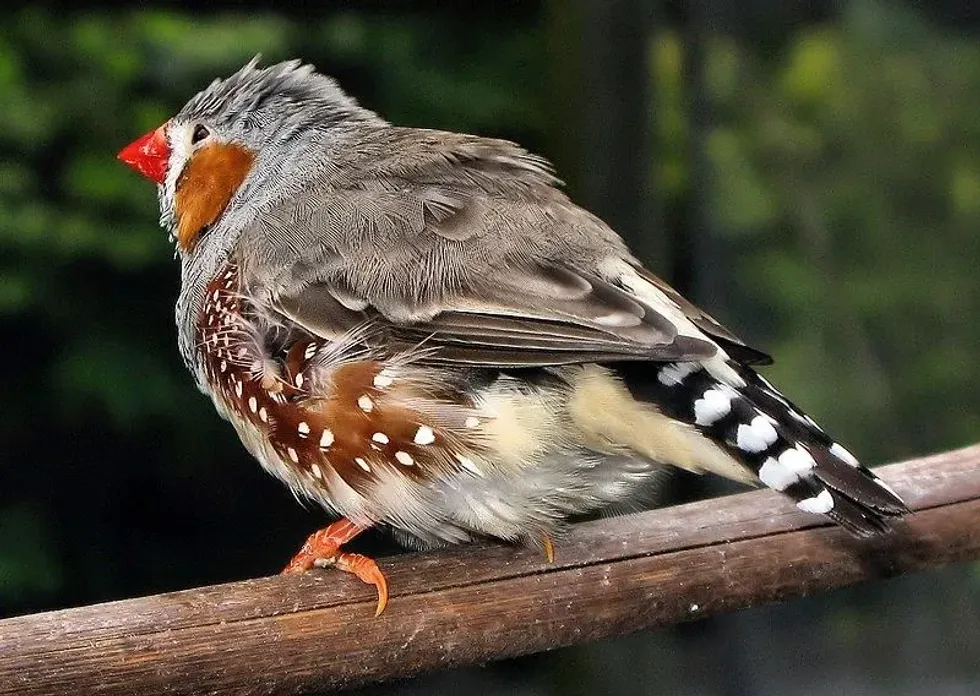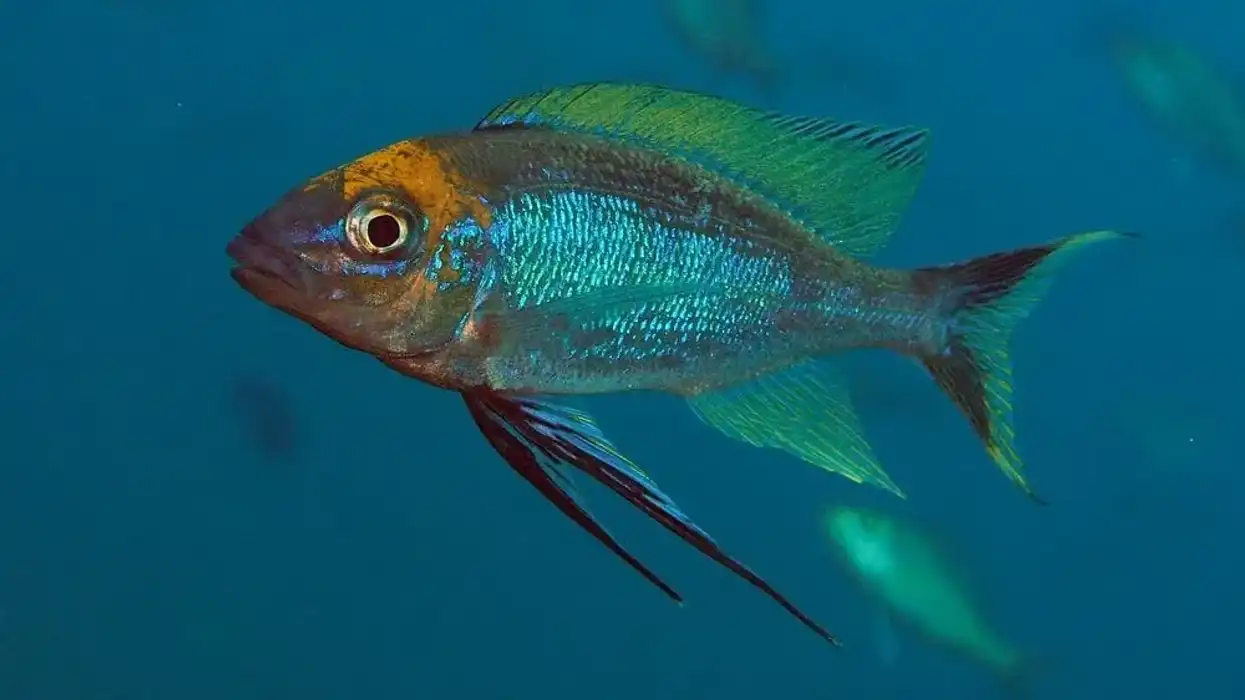One of the most common estrildid finches of central Australia, the zebra finch (scientific name: Taeniopygia guttata) is known for its attractive bright orange bill.
These small birds generally weigh around 0.5-1.1 oz (15-30 g) while their average length is 3.9-4.3 in (10-11 cm). These birds are dimorphic as males and females differ in color. The male bird has a gray back and head, a striped black and white tail, an orange cheek, and a spotted chestnut coloration on the sides.
Meanwhile, females possess gray coloration on the entire body. Unlike male zebra finches, the female possesses an orange-colored bill. A juvenile generally resembles a female but has a black bill.
Zebra finches inhabit terrains or areas with scattered trees and shrubs, and arid areas with freshwater also serve as their habitat. Also, for decades, these birds have been living around human settlements and among cleared vegetation that has been used for commercial purposes.
This bird species is also found in the Timor Islands of Southeast Asia and has also been introduced to countries such as Portugal and Puerto Rico.
Zebra finches are omnivores and mainly feed on seeds, fruits, vegetables, and insects. Insects are very crucial to raise young birds during the breeding season. The International Union for Conservation of Nature listed the species in the Least Concern category as the population is not declining and predation is the only major threat to these zebra finches.
Keep on reading to learn more interesting facts about the zebra finch. For more relatable content, check out these mockingbird facts and blue jay facts for kids.
Zebra Finch Interesting Facts
What type of animal is a zebra finch?
One of the most common Estrildid finches, the zebra finch (Taeniopygia guttata) is a beautiful bird that is majorly found in central Australia. Zebra finches are omnivores and mainly feed on seeds, fruits, vegetables, and insects. Insects are very crucial to raise young birds during the breeding season.
What class of animal does a zebra finch belong to?
The zebra finch belongs to the class of Aves, the family of Estrildidae, and the Taeniopygia genus. These birds are from the family of small seed-eating passerine birds.
How many zebra finches are there in the world?
The exact population of zebra finches is not known as of now but the species is widely distributed in central Australia. Also, the species has been listed in the Least Concern category as the population is stable and the bird has no major threats currently.
Where does a zebra finch live?
Zebra finches are found in central Australia and a recent survey reveals that the species is found in about 75% of mainland Australia. Zebra finches are also found in the Timor Islands of Southeast Asia and they have also been introduced to countries such as Portugal and Puerto Rico
What is a zebra finch's habitat?
Zebra finches generally inhabit savanna and subtropical dry habitats. These birds are found in arid areas that are close to freshwater, and you can also find them in scattered trees and shrubs. For decades, these birds have also been living around human settlements, among cleared vegetation that has been used for commercial purposes.
Who do zebra finches live with?
Like other birds, zebra finches are social birds that are found in large flocks. These sedentary birds are diurnal and generally remain active during the daytime.
Their flocks generally consist of around 100 birds. During the breeding season, their flocks break into smaller groups of 50 individuals, but even after breaking, the birds remain in contact with each other as they don't do well alone.
How long does a zebra finch live?
The typical zebra finch lifespan generally varies according to genetic and environmental factors. These birds usually live up to five years in the wild, while they can survive up to around five to nine years of age in captivity.
Some of them have lived for around 12 years, while a study reveals the one caged bird has lived for 14.5 years! It is said that the age of zebra finches generally increases if kept in captivity.
How do they reproduce?
The zebra finch breeding season generally varies as both males and females can mate at any point of the year following heavy amounts of rainfall. These small birds are monogamous which means each pair stays with each other for life.
Before mating, a change in male and female zebra finches' behavior can be seen. Courtship displays generally involve different songs and body movements.
Male zebra finch birds possess original songs that are used to attract a zebra finch female bird, and they also dance, unlike females. A hissing noise is also produced to protect their territory and to protect their partner.
After mating, both parents generally construct the nest, and zebra finch nesting material generally includes grasses, feathers, and wool. You will find a zebra finch nest either on trees, in bushes, or in animal burrows. Pairs can often construct their nest on cavities in commercial buildings as well.
Females generally lay around four to six eggs over a period of few days and both parents are involved in incubating the eggs. The incubation period usually lasts for around two weeks, during which males become very protective of females and nests.
The chicks generally stay in their nests until they reach independence and both males and females are involved in feeding and parental care.
What is their conservation status?
The International Union for Conservation of Nature listed the species in the Least Concern category as their population is not declining and predation is the only major threat to these zebra finches. Predators such as tiger snakes, brown snakes, pygmy mulga monitors, dragon lizards, black rats, little crows, and many others often feed on them.
Zebra Finch Fun Facts
What do zebra finches look like?
Zebra finches are dimorphic as males and females differ in color. The male bird has a gray back and head, a striped black and white tail, an orange cheek, and a spotted chestnut coloration on the sides can also be observed.
Meanwhile, females possess gray coloration on the entire body. Unlike male zebra finches, the female possesses an orange-colored bill. A juvenile generally resembles a female but has a black bill.
How cute are they?
Zebra finches are one of the most adorable birds you will ever find. They are social birds and they generally live in a group.
A funny fact about them is that they only allow friendly members of the group to enter the nesting site and they decide on this by listening to their songs. Also, their calls sound like tiny little car horns.
How do they communicate?
Like other birds, zebra finches use similar methods to communicate with each other, they generally use vocalizations and body movements. Zebra finch noises are used to warn predators and intruders, zebra finch sounds generally involve peeing and beeping. Also, the juveniles produce a chirping and scratching noise to stimulate the feeding response of their parents.
How big is a zebra finch?
Zebra finches generally weigh around 0.5-1.1 oz (15-30 g) while their average length is 3.9-4.3 in (10-11 cm). The bird is twice the size of bee hummingbirds and ruby-crowned kinglets.
How fast can a zebra finch fly?
Zebra finches can easily fly at a speed of 7.8 mph (12.6 kph), and these birds generally fly in their native range. They are known for their agility skills.
How much does a zebra finch weigh?
The average weight of zebra finches is around 0.5-1.1 oz (15-30 g).
What are their male and female names of the species?
There are no specific names given to a zebra finch male or female bird. Unlike the female, the zebra finch male is quite colorful, it has a gray back and head, a striped black and white tail, an orange cheek, and a spotted chestnut coloration on the sides.
What would you call a baby zebra finch?
Zebra finch babies are called chicks. In the wild, they generally stay in their nests for two weeks.
What do they eat?
Zebra finches are omnivores and they primarily feed on seeds, insects, fruits, and vegetables. These birds are mainly preyed upon by different species of snakes and other animals such as tiger snakes, brown snakes, pygmy mulga monitors, dragon lizards, mice, and many more. In the wild, these birds feed on seeds in their native range only.
Are they dangerous?
Zebra finches are small birds that pose no danger or threat to humans. Males are generally quite territorial though, and they could attack and bite if someone tries to approach or provoke them.
Would they make a good pet?
The zebra finch is a sweet-tempered bird that can easily make a great pet. However, factors such as appropriate housing and the ideal zebra finch temperature range should be considered properly to provide the best possible zebra finch care.
The height of the aviary is not hugely important, but it should be large enough for flying. An aviary of 30 in (76.2 cm) in length, 18 in (45.7 cm) in height, and 18 in (45.7 cm) in width could be a good idea.
Some owners attach swings and ladders as well. Areas with direct sunlight and heat or air conditioning ducts should be avoided as they will alter the temperature of the zebra finch cage setup.
Don't forget to add a dish of fresh water multiple times a week for bathing. A pair of zebra finch pets can be kept together.
As we know, they mainly feed on seeds, so two teaspoons of good quality finch seed mix should be provided to these birds each day. A variety of vegetables such as lettuce, dandelion greens, kale, and spinach can be great options too, but never feed them avocados.
You can often find a zebra finch for sale online or in pet shops, priced between $20 to $100. Different zebra finch mutations in the breed may affect the price of each bird.
Did you know...
Only two zebra finches can be kept together.
Zebra finches are so smart that they dream while they are asleep!
How to tell males from female zebra finches?
These birds are dimorphic as males and females differ in color. The male bird has a gray back and head, a striped black and white tail, an orange cheek, and a spotted chestnut coloration on the sides, while females possess gray coloration on the entire body. Unlike male zebra finches, the female possesses an orange-colored bill too.
How long does it take zebra finch eggs to hatch?
Females generally lay around four to six eggs over a period of few days and both parents are involved in incubating the eggs. The incubation period usually lasts for around two weeks. Males become very protective of females and nests during this period.
Here at Kidadl, we have carefully created lots of interesting family-friendly animal facts for everyone to discover! Learn more about some other birds from our Amazon parrot facts and cockatoo facts for kids pages.
You can even occupy yourself at home by coloring in one of our free printable Zebra finch coloring pages.









